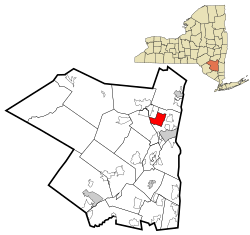Kingston (town), New York
| Kingston, New York | |
|---|---|
| Town | |
 Location in Ulster County and the state of New York. |
|
| Coordinates: 41°59′28″N 74°3′26″W / 41.99111°N 74.05722°WCoordinates: 41°59′28″N 74°3′26″W / 41.99111°N 74.05722°W | |
| Country | United States |
| State | New York |
| County | Ulster |
| Area | |
| • Total | 7.75 sq mi (20.07 km2) |
| • Land | 7.70 sq mi (19.95 km2) |
| • Water | 0.05 sq mi (0.13 km2) |
| Elevation | 476 ft (145 m) |
| Population (2010) | |
| • Total | 889 |
| • Estimate (2016) | 884 |
| • Density | 114.78/sq mi (44.31/km2) |
| Time zone | Eastern (EST) (UTC-5) |
| • Summer (DST) | EDT (UTC-4) |
| ZIP codes | 12401-12402 |
| Area code(s) | 845 |
| FIPS code | 36-39738 |
| GNIS feature ID | 0979119 |
Kingston is a town in Ulster County, New York, United States. The Town of Kingston is in the northeast part of Ulster County, north of the City of Kingston. Kingston is inside the Catskill Park. The population was 889 at the 2010 census.
The original Town of Kingston was settled around 1611, primarily as a military post, but that part of the town is now the City of Kingston. The town was formed by a patent granted in 1667 and its status as a town was reaffirmed in 1702. The current town does not border the city of Kingston.
In 1811, part of the Town of Kingston was used to form the Towns of Esopus and Saugerties. Additional parts of Kingston were used to set apart the City of Kingston in 1827 and the in 1879.
The quarrying industry brought many immigrant laborers to the town, and these new arrivals established themselves in the few communities within this town.
The community takes its name from the sawmills plus “kill” the Dutch word for creek.
On January 1, 1765, William Legg bought around 100 acres of land lying on both sides of the Saw Kill. This was one of the first purchases to be made in the present town of Kingston. Legg built a sawmill and a house. The Legg family lived there for 88 years. It was reported that they ground wheat in the mill for the Continental Army. Saw mill and grist mill construction were commonplace along the Saw Kill River by the end of the 18th century. Milling died down by the end of the 19th due to decreased profitability.
The next owner was James Gaddis. He continued the milling operations and denied requests of people to use the land for quarrying. However, in the 1880s a fire destroyed both the house and the mill. Gaddis, needing money to rebuild, gave permission for quarrying bluestone on the Saw Mill creek ledge. The extensive quarrying moved the falls that were located by the mill back 300 feet.
Howe’s Mill was another mill located on the Saw Kill. It was powered by a dam at Little Falls. The mill was used to make gunpowder and there were frequently explosions. The mill stayed mostly intact, however, and continued operating until the 1860s when it was hit by lightning.
Bluestone quarrying in the area increased in 1828 when the Delaware and Hudson Canal was being built. Bluestone was used to pave sidewalks in New York, Albany, and Kingston and was shipped all over the world. Entrepreneurs bought up the rocky ground and brought unskilled immigrants, mostly Irish, upriver from Manhattan. Sawkill became a "quarry-town" with company owned housing.
...
Wikipedia
